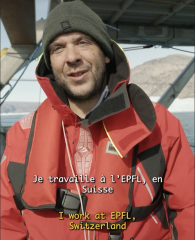The objective is to deploy the SubOcean laser probe to characterize methane greenhouse gas fluxes and to determine whether subglacial meltwater constitutes a significant source of this gas.
Recent studies suggest that methane may travel through subglacial waters and be released into Arctic fjords. These fjords could act as natural filters, where methane is oxidized into carbon dioxide and water before reaching the atmosphere.
However, if glaciers continue to melt and these filtering processes weaken, methane — a greenhouse gas far more potent than carbon dioxide — could be released directly into the atmosphere.
This pressing question is central to the research conducted aboard FOREL this summer.
Sébastien is an R&D engineer in the SENSE unit (Smart Environmental Sensing in Extreme Environments), led by Jérôme Chappellaz at EPFL’s ENAC faculty. The lab develops innovative sensor technologies to improve environmental data collection in extreme conditions, including the detection of greenhouse gases in aquatic systems.
Video credit: Richard Mardens / FOREL
To watch the full video, please visit our Instagram account here.




